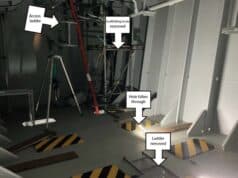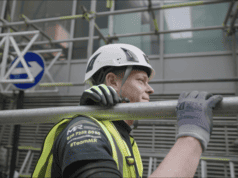Competent Scaffolder will now be Qualified Scaffolder after regulations review.
ScaffMag has been informed by sources that the National Access & Scaffolding Confederation (NASC) has managed to persuade government bigwigs to replace the terminology ‘Competent’ or ‘Competence’ with ‘Qualified’ in the next updated Working at Height Regulations.
Although no official announcement from the NASC has been published as yet, The NASC are reportedly very happy with the outcome.
The battle began back in January 2012 after a government report by Professor Löfstedt on the review into existing Health and Safety legislation. One recommendation by Professor Löfstedt was to review the Work at Height Regulations by 2013. The NASC reacted with its own recommendation in shining light on one particular ‘grey’ area in the use of the terminology ‘competent’ and ‘competence’ which occur frequently throughout the current legislation.
These terms were both ambiguous and open to interpretation. This non-specific terminology has resulted in different interpretations and hence different standards of safety protocol – yet these terms are also at the ‘heart’ of the regulations. The NASC recommended that this terminology be replaced by the term ‘qualified’ (as already adopted in the gas fitting industry).
The work at height industry, including scaffolding can demonstrate clearly and accurately that an individual is ‘qualified’ by the fact that he or she has completed suitable training, which includes theoretical, practical and on site experience – the aptitude of the Scaffolder to continue to carry out his/her skilled works is also challenged every five years to ensure continued compliance.
Image source: CISRS
























There should be a minimum time spent learning the game before being considered for parts 1 and 2 , not that I’ve anything against fixers without tickets, I have an advanced ticket and have worked in every aspect of scaffolding and I’ve met guys with no ticket that were bloody good scaffolders and some cunts as well, both with and without tickets. There’s is no easy answer.
These tickets are joke iv had guys from an agency that have part 2 an don’t even know how to put a return in . I’ve been scaffolding twenty years an the standard of scaffolding then was better than now and I’d much rather a guy that’s spent a few years being taught hands on than some goon that’s done a couple of weeks for a bit of paper .
scaffmag ragscaff
Our reply is from the policy section of the HSE who would make any changes. As you know from my work with the SCCR we did a lot of work with the HSE on SG4 10.
ragscaff We was informed by a very good source with the regard to this story.. but as quoted in the article above: “No official announcement from the NASC has been published as yet!”
Where is your quote from ?
Would like to know who at the NASC has stated this as it is wrong.
Quote
NASC were campaigningtwo years ago about wanting to change ‘competent’ to ‘qualified’.Nowhere does it reference ‘qualified’ in the regulations.The WAHR implement an EC Directive, i.e. you can’t change the regs without changing the Directive and there is no appetite in Europe to change the Directive and even if there was, it would take years as you need the agreement of all EU members states etc !!!The WAHR were reviewed by 2013, as per Lofstedt. we reviewed the guidance in order to simplify them, the regs remained unchanged as research confirmed that people struggled interpreting the guidance not the regs.
Just the start!! Next it will be CISRS for NASC only scaffolders!!!
Scott Grant ^^^ ????
Hey Scott Grant who was that from mancat? I went there and my Dad was a tutor there. I had scaffolded for 2 years with a very good Scaffolder who taught me everything I know then got chucked into Mancat with some proper drongo’s who didnt have a clue.
Need to labour for a couple of yrs to learn the job first then do ur tickets far to many idiots do a weeks course and think they no the job! Dangerous!!
Labour,part 1 then part 2,nowadays prison for a couple of years then fast tracked part 1 n 2,I had one frm mancat he was shocking dnt no how he never killed himself
Competence is measured by 3 factors: Knowledge, Experience and Qualifications. I’d hesitate to let anyone without all 3 to Scaffold without supervision. I’ve got no time for novices with Part 2’s OR old heads who refuse to adopt new techniques/guidelines. It’s up to competent scaffolders to maintain professional standards and evolve in the industry instead of moaning and clinging on to the bad old ways
ScaffoldingNews good news dan. They should be longer durations between courses to gain experience. To many are getting/have advanced cards.
ScaffoldingNews see if we all can replace incompetent with qualified putting the scaffolds up. It starts at a personal level of acceptance.